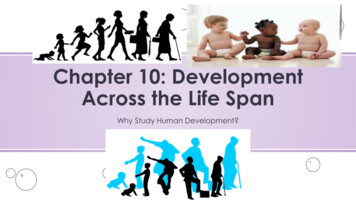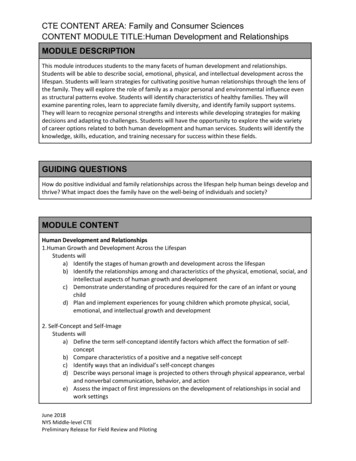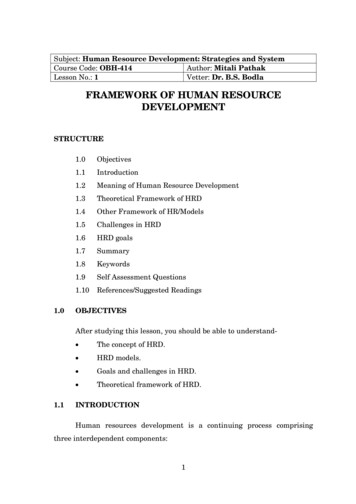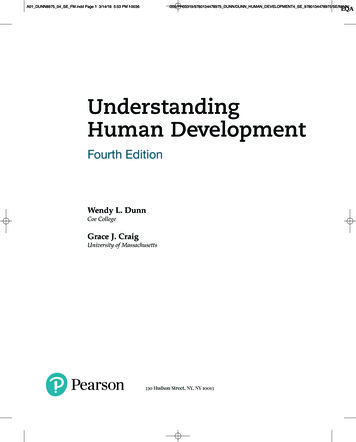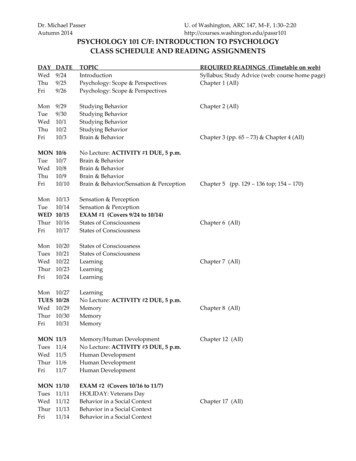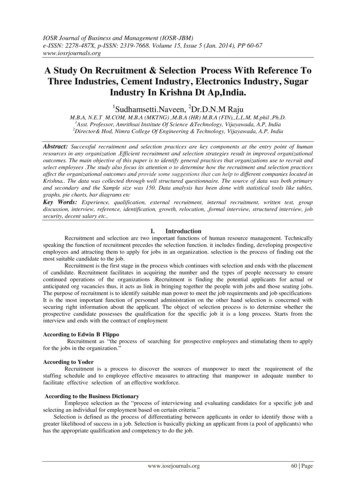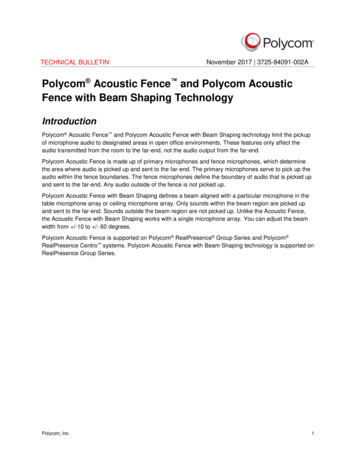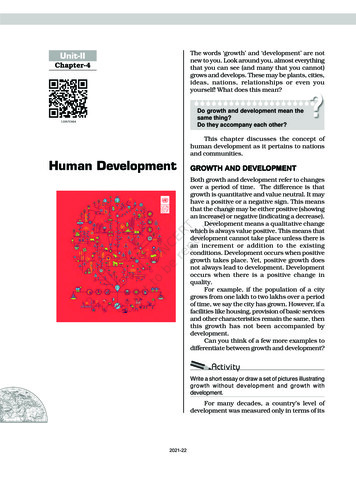
Transcription
The words ‘growth’ and ‘development’ are notnew to you. Look around you, almost everythingthat you can see (and many that you cannot)grows and develops. These may be plants, cities,ideas, nations, relationships or even youyourself! What does this mean?Unit-IIChapter-4Do growth and development mean thesame thing?Do they accompany each other?This chapter discusses the concept ofhuman development as it pertains to nationsand communities.Human DevelopmentOPMENTDEVELOPMENTGROWTHWTH AND DEVELGROBoth growth and development refer to changesover a period of time. The difference is thatgrowth is quantitative and value neutral. It mayhave a positive or a negative sign. This meansthat the change may be either positive (showingan increase) or negative (indicating a decrease).Development means a qualitative changewhich is always value positive. This means thatdevelopment cannot take place unless there isan increment or addition to the existingconditions. Development occurs when positivegrowth takes place. Yet, positive growth doesnot always lead to development. Developmentoccurs when there is a positive change inquality.For example, if the population of a citygrows from one lakh to two lakhs over a periodof time, we say the city has grown. However, if afacilities like housing, provision of basic servicesand other characteristics remain the same, thenthis growth has not been accompanied bydevelopment.Can you think of a few more examples todifferentiate between growth and development?Write a short essay or draw a set of pictures illustratinggrowth without development and growth withdevelopment.For many decades, a country’s level ofdevelopment was measured only in terms of its2021-22
Band Aceh, June, 2004Band Aceh, December, 2004Do you know that cities can also grow negatively? Look at the photographs of this tsunamiaffected city. Are natural disasters the only reasons for negative growth in a city’s size?economic growth. This meant that the biggerthe economy of the country, the more developedit was considered, even though this growth didnot really mean much change in the lives of mostpeople.The idea that the quality of life people enjoyin a country, the opportunities they have andfreedoms they enjoy, are important aspects ofdevelopment, is not new.These ideas were clearly spelt out for thefirst time in the late eighties and early nineties.The works of two South Asian economists,Mahbub-ul-Haq and Amartya Sen areimportant in this regard.The concept of human development wasintroduced by Dr Mahbub-ul-Haq. Dr Haq hasdescribed human development as developmentthat enlarges people’s choices and improvestheir lives. People are central to all developmentunder this concept. These choices are not fixedbut keep on changing. The basic goal ofdevelopment is to create conditions wherepeople can live meaningful lives.A meaningful life is not just a long one. Itmust be a life with some purpose. This meansthat people must be healthy, be able to developtheir talents, participate in society and be freeto achieve their goals.Dr Mahbub-ul-Haq and Prof Amartya Sen were close friends and have worked together under the leadership of DrHaq to bring out the initial Human Development Reports. Both these South Asian economists have been able toprovide an alternative view of development.A man of vision and compassion, Pakistani economist Dr Mahbub-ul-Haq created the Human DevelopmentIndex in 1990. According to him, development is all about enlarging people’s choices in order to lead long,healthy lives with dignity. The United Nations Development Programme has used his concept of human developmentto publish the Human Development Report annually since 1990.Dr Haq’s flexibility of mind and ability to think out of the box can be illustrated from one of his speeches wherehe quoted Shaw saying, “‘You see things that are, and ask why? I dream of things that never were, and ask whynot?’Nobel Laureate Prof Amartya Sen saw an increase in freedom (or decrease in unfreedom) as the main objectiveof development. Interestingly, increasing freedoms is also one of the most effective ways of bringing aboutdevelopment. His work explores the role of social and political institutions and processes in increasing freedom.The works of these economists are path breaking and have succeeded in bringing people to the centre of anydiscussion on development.Human Development2021-2223
What is a Meaningful Life?The Government of India has introducedBeti Bachao Beti Padhao programme toaddress the issue of decline in child sexratio. Discuss with your peers how it willlead to more meaningful life for girls.Which of these lives is a meaningful life?Who do you think leads more meaningful life? What makes one of these more meaningful than the other?24Fundamentals of Human Geography2021-22
Leading a long and healthy life, being ableto gain knowledge and having enough meansto be able to live a decent life are the mostimportant aspects of human development.Therefore, access to resources, health andeducation are the key areas in humandevelopment. Suitable indicators have beendeveloped to measure each of these aspects. Canyou think of some?Very often, people do not have thecapability and freedom to make even basicchoices. This may be due to their inability toacquire knowledge, their material poverty,social discrimination, inefficiency of institutionsand other reasons. This prevents them fromleading healthy lives, being able to get educatedor to have the means to live a decent life.Building people’s capabilities in the areasof health, education and access to resources istherefore, important in enlarging their choices.If people do not have capabilities in these areas,their choices also get limited.For example, an uneducated child cannotmake the choice to be a doctor because herchoice has got limited by her lack of education.Similarly, very often poor people cannot chooseto take medical treatment for disease becausetheir choice is limited by their lack of resources.Enact a five-minute play with your classmates showinghow choices are limited due to lack of capability in theareas of either income, education or health.THE FOUR PILLARS OF HUMANDEVELOPMENTDEVELOPMENTJust as any building is supported by pillars,the idea of human development is supportedby the concepts of equity, sustainability,productivity and empowerment.Equity refers to making equal access toopportunities available to everybody. Theopportunities available to people must be equalirrespective of their gender, race, income andin the Indian case, caste. Yet this is very oftennot the case and happens in almost everysociety.For example, in any country, it is interestingto see which group the most of the schooldropouts belong to. This should then lead to anunderstanding of the reasons for such behaviour.In India, a large number of women and personsbelonging to socially and economicallybackward groups drop out of school. This showshow the choices of these groups get limited bynot having access to knowledge.Sustainability means continuity in theavailability of opportunities. To havesustainable human development, eachgeneration must have the same opportunities.All environmental, financial and humanresources must be used keeping in mind thefuture. Misuse of any of these resources willlead to fewer opportunities for futuregenerations.A good example is about the importanceof sending girls to school. If a community doesnot stress the importance of sending its girlchildren to school, many opportunities will belost to these young women when they grow up.Their career choices will be severely curtailedand this would affect other aspects of their lives.So each generation must ensure the availabilityof choices and opportunities to its futuregenerations.Productivity here means human labourproductivity or productivity in terms of humanwork. Such productivity must be constantlyenriched by building capabilities in people.Ultimately, it is people who are the real wealthof nations. Therefore, efforts to increase theirknowledge, or provide better health facilitiesultimately leads to better work efficiency.Empowerment means to have the powerto make choices. Such power comes fromincreasing freedom and capability. Goodgovernance and people-oriented policies arerequired to empower people. The empowermentof socially and economically disadvantagedgroups is of special importance.Talk to the vegetable vendor in your neighbourhood andfind out if she has gone to school. Did she drop out ofschool? Why? What does this tell you about her choicesand the freedom she has? Note how her opportunitieswere limited because of her gender, caste and income.Human Development2021-2225
APPROACHES TO HUMANDEVELOPMENTThere are many ways of looking at the problemof human development. Some of the importantapproaches are: (a) The income approach; (b) Thewelfare approach; (c) Minimum needs approach;and (d) Capabilities approach (Table 4.1).MEASURING HUMAN DEVELOPMENTThe human development index (HDI) ranks thecountries based on their performance in the keyareas of health, education and access toresources. These rankings are based on a scorebetween 0 to 1 that a country earns from itsrecord in the key areas of human development.The indicator chosen to assess health isthe life expectancy at birth. A higher lifeexpectancy means that people have a greaterchance of living longer and healthier lives.The adult literacy rate and the grossenrolment ratio represent access to knowledge.The number of adults who are able to read andwrite and the number of children enrolled inschools show how easy or difficult it is to accessknowledge in a particular country.Access to resources is measured in termsof purchasing power (in U.S. dollars).Each of these dimensions is given aweightage of 1/3. The human developmentindex is a sum total of the weights assigned toall these dimensions.The closer a score is to one, the greater isthe level of human development. Therefore, ascore of 0.983 would be considered very highwhile 0.268 would mean a very low level ofhuman development.The human development index measuresattainments in human development. It reflectswhat has been achieved in the key areas ofhuman development. Yet it is not the mostreliable measure. This is because it does notsay anything about the distribution.The human poverty index is related to thehuman development index. This indexmeasures the shortfall in human development.Table 4.1: Approaches to Human Development26(a)Income ApproachThis is one of the oldest approaches to humandevelopment. Human development is seen as beinglinked to income. The idea is that the level of incomereflects the level of freedom an individual enjoys.Higher the level of income, the higher is the level ofhuman development.(b)Welfare ApproachThis approach looks at human beings as beneficiariesor targets of all development activities. The approachargues for higher government expenditure oneducation, health, social secondary and amenities.People are not participants in development but onlypassive recipients. The government is responsible forincreasing levels of human development bymaximising expenditure on welfare.(c)Basic Needs ApproachThis approach was initially proposed by theInternational Labour Organisation (ILO). Six basicneeds i.e.: health, education, food, water supply,sanitation, and housing were identified. The questionof human choices is ignored and the emphasis is onthe provision of basic needs of defined sections.(d)Capability ApproachThis approach is associated with Prof. Amartya Sen.Building human capabilities in the areas of health,education and access to resources is the key toincreasing human development.Fundamentals of Human Geography2021-22
Bhutan is the only country in the world toofficially proclaim the Gross NationalHappiness (GNH) as the measure of thecountry’s progress. Material progress andtechnological developments are approachedmore cautiously taking into consideration thepossible harm they might bring to theenvironment or the other aspects of culturaland spiritual life of the Bhutanese. This simplymeans material progress cannot come at thecost of happiness. GNH encourages us tothink of the spiritual, non-material andqualitative aspects of development.Since 1990, the United NationsDevelopment Programme (UNDP) has beenpublishing the Human Development Reportevery year. This report provides a rank-wiselist of all member countries according to thelevel of human development. The HumanDevelopment index and the Human Povertyindex are two important indices to measurehuman development used by the UNDP.It is a non-income measure. The probability ofnot surviving till the age of 40, the adult illiteracyrate, the number of people who do not haveaccess to clean water, and the number of smallchildren who are underweight are all taken intoaccount to show the shortfall in humandevelopment in any region. Often the humanpoverty index is more revealing than the humandevelopment index.Looking at both these measures of humandevelopment together gives an accurate pictureof the human development situation in acountry.The ways to measure human developmentare constantly being refined and newer ways ofcapturing different elements of humandevelopment are being researched. Researchershave found links between the level of corruptionor political freedom in a particular region. Thereis also a discussion regarding a politicalfreedom index and, a listing of the most corruptcountries. Can you think of other links to thelevel of human development?INTERNATIONAL COMPARISONSInternational comparisons of humandevelopment are interesting. Size of the territoryand per capita income are not directly relatedto human development. Often smaller countrieshave done better than larger ones in humandevelopment. Similarly, relatively poorer nationshave been ranked higher than richer neighboursin terms of human development.For example, Sri Lanka, Trinidad andTobago have a higher rank than India in thehuman development index despite havingsmaller economies. Similarly, within India,Kerala performs much better than Punjab andGujarat in human development despite havinglower per capita income.Countries can be classified into fourgroups on the basis of the human developmentscores earned by them (Table 4.2).Table 4.2: Human Development: Categories, Criteriaand CountriesScore inDevelopmentIndexNumber ofCountriesabove 0.80066Highbetween 0.700up to 0.79953Mediumbetween 0.550up to 0.69937below 0.54933Level of HumanDevelopmentVery HighLowSource: Human Development Report, 2020Human Development2021-2227
Countries with very high human developmentindex are those which have a score of over 0.800.According to the Human Development Reportof 2020, this group includes 66 countries. Table4.3 shows the top ten countries in this group.Table 4.3: Top Ten Ranked Countries with HighValue tzerland8.Hongkong, (China) SAR dsDenmarkSource: Human Development Report, 2020Try to locate these countries on a map.Can you see what these countries have incommon? To find out more visit the officialgovernment websites of these countries.High level of human development grouphas 53 countries. Providing education andhealthcare is an important government priority.Countries with higher human development arethose where a lot of investment in the socialsector has taken place. Altogether, a higherinvestment in people and good governance hasset this group of countries apart from the others.Try to find out the percentage of thecountry’s income spent on these sectors. Canyou think of some other characteristics thatthese countries have in common?You will notice that many of these countrieshave been the former imperial powers. The degreeof social diversity in these countries is not veryhigh. Many of the countries with a high humandevelopment score are located in Europe andrepresent the industrialised western world. Yetthere are striking numbers of non-Europeancountries also who have made it to this list.Countries with medium levels of humandevelopment form the largest group. There are37 countries in the medium level of humandevelopment. Most of these are countries whichhave emerged in the period after the SecondWorld War. Some countries from this group wereformer colonies while many others have emergedafter the break up of the erstwhile Soviet Unionin 1990. Many of these countries have beenrapidly improving their human developmentscore by adopting more people-oriented policiesand reducing social discrimination. Most ofthese countries have a much higher socialdiversity than the countries with higher humandevelopment scores. Many in this group haveIndia was 126thin HumanDevelopmentIndex as perHumanDevelopmentReport, 2006.According to HDIreport 2020,India’s rank hasfurther gonedown to 131.What could bethe reason forIndia to bebehind 130countries in HDI?28Fundamentals of Human Geography2021-22
faced political instability and social uprisingsat some point of time in their recent history.As many as 33 countries record low levelsof human development. A large proportion ofthese are small countries which have been goingthrough political turmoil and social instabilityin the form of civil war, famine or a highincidence of diseases. There is an urgent needto address the human developmentrequirements of this group through wellthought out policies.International comparisons of humandevelopment can show some very interestingresults. Often people tend to blame low levelsof human development on the culture of thepeople. For example, X country has lowerhuman development because its people followY religion, or belong to Z community. Suchstatements are misleading.To understand why a particular regionkeeps reporting low or high levels of humandevelopment it is important to look at thepattern of government expenditure on thesocial sector. The political environment of thecountry and the amount of freedom peoplehave is also important. Countries with highlevels of human development invest more inthe social sectors and are generally free frompolitical turmoil and instability. Distributionof the country’s resources is also far moreequitable.On the other hand, places with low levelsof human development tend to spend more ondefence rather than social sectors. This showsthat these countries tend to be located in areasof political instability and have not been ableto initiate accelerated economic development.EXERCISES1.Choose the right answer from the four alternatives given below.(i)(ii)2.(a) an increase in size(c)a positive change in quality(b) a constant in size(d)a simple change in the qualityWhich one of the following scholars introduced the concept of HumanDevelopment?(a) Prof. Amartya Sen(c)Dr Mahabub-ul-Haq(b) Ellen C. Semple(d)RatzelAnswer the following questions in about 30 words.(i)(ii)(iii)3.Which one of the following best describes development?What are the three basic areas of human development?Name the four main components of human development?How are countries classified on the basis of human development index?Answer the following questions in not more than 150 words.(i)(ii)What do you understand by the term human development?What do equity and sustainability refer to within the concept of humandevelopment?Human Development2021-2229
Project/ActivityMake a list of the ten most corrupt countries and ten least corrupt countries.Compare their scores on the human development index. What inferences canyou draw?Consult the latest Human Development Report for this.30Fundamentals of Human Geography2021-22
The human development index is a sum total of the weights assigned to all these dimensions. The closer a score is to one, the greater is the level of human development. Therefore, a score of 0.983 would be considered very high while 0.268 would mean a very low level of human development. The human development

